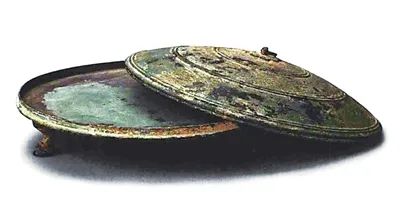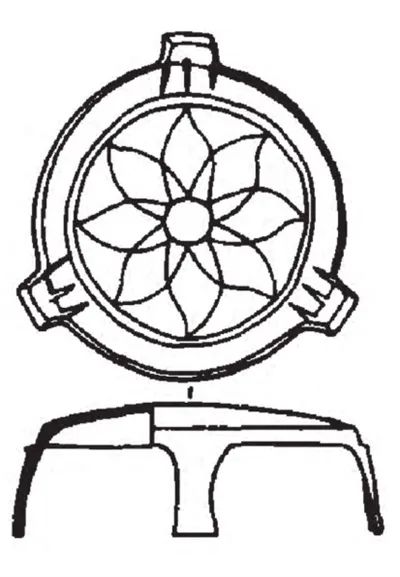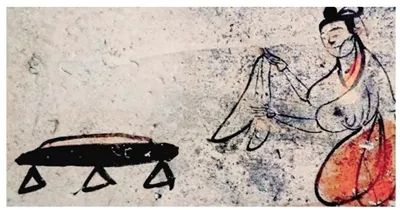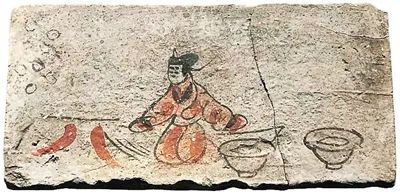Pancake Pan: A tool for frying pancakes that have been around for thousands of years. 1972 | Pancake
A pottery pot unearthed from the Yangshao Culture Site in Qingtai Village, Guangwu Town, Xingyang City, Henan Province.
Aozi is the main tool for making hot cakes and spreading pancakes. In the Qing Dynasty's "Shuowen Sentence Reading", it was recorded that "pan, with a round and flat surface, three legs, about two inches high, is also called a pancake pan." The Ming Dynasty's "Zhengzi Tong" also recorded that "pan, now known as a pancake pan, is also called a pancake pan." In ancient times, a pan was made by grinding a thin stone into a turtle back shape, then grinding it smooth. It can be heated on fire below, and can be used to heat a bun or spread pancakes on top. It was a cooking utensil specifically used for pancakes.
The frying tools are constantly updated, and the roasting technology has a long history
In the Neolithic sites of our country, a type of disc-shaped pottery with three legs on the edge is often unearthed. At first, there was no unified understanding among cultural relics experts. It was not until the spring of 1981 that archaeologists at the Zhengzhou Museum in Henan Province excavated a intact pottery at the Yangshao Culture Site in Qingtai Village, Guangwu Town, Xingyang City, Henan Province. It was in the shape of a covered plate, with three tile shaped feet, a smooth outer surface, rough inner wall, and thick soot attached. According to expert research, this is the tool used to cook food that has been passed down for thousands of years and is still used today - the pan. Due to its texture being pottery, it is called a pottery pan.
Some people once believed that China's noodle making technology was introduced from outside the Han Dynasty, but the discovery and confirmation of pottery pots proved that China had mastered the traditional roasted food technology during the Neolithic period.

With the emergence of bronze and iron tools, pottery pots were gradually replaced. In March 1989, a Han Dynasty bronze ware cellar was discovered in the brick and tile kiln of Jiahetun Forest Farm in Jiaozuo City, Henan Province. An extremely rare bronze pot with a cover and string pattern was unearthed.
The bronze pan is composed of a cover and a body, with an umbrella shaped cover and two sets of string patterns on the top. There is a bridge shaped button at the top, and a plum blossom shaped decorative piece is decorated below the button. A circular lifting ring is placed on the button. The body is a circular shallow plate with a flat bottom and three hoofed feet attached below. There are mother and child openings around the lid that are tightly integrated with the flat surface. According to research, this is the earliest bronze pot with a lid discovered in Chinese archaeology, and it is a precious physical material for studying ancient culinary culture.
In the cellar remains of Inner Mongolia, Liaoning, Henan, Shanxi, Shandong and other regions in China, iron pans are common artifacts from the Liao and Jin dynasties. In October 1982, an iron pan with an eight petal lotus flower pattern was unearthed from the Xixia cellar in Zhungeerzhao Town, Zhunge'er Banner, Inner Mongolia Autonomous Region; In August 1996, a Jin Dynasty iron pot was discovered in Xiuyan Manchu Autonomous County, Liaoning Province, with a nine petal lotus flower pattern cast on the back.
Bronze pot from the Han Dynasty cellar was unearthed from Jiahetun Forest Farm in Jiaozuo City, Henan Province.
▲ Xixia Iron Cao Unearthed in Zhungeerzhao Town, Zhunge'er Banner, Inner Mongolia Autonomous Region

Pancake Chart: Showcasing the scene of ancient people using a pan
In archaeological excavations, the images of ancient people using a pan to make pancakes not only preserve precious cultural information, but also make up for the lack of physical information. These images vividly and intuitively reflect the scene of using a pan, recording and displaying the labor scenes of ancient people.
In the Hexi area of Gansu Province, a large number of mural brick tombs from the Wei and Jin dynasties have been excavated, among which many "pancake pictures" are eye-catching. In 1972, a pancake painting was excavated from the Wei Jin mural tomb in Jiayuguan City, Gansu Province. A woman was holding a dough and placing it on a pan. In 1993, the Wei and Jin tombs in Xigou Village, Guoyuan Township, Jiuquan City, Gansu Province, also discovered the "pancake map". A woman with a bun on her head knelt in front of a three legged flat bottomed pan to make pancakes, with two large pots placed behind her.
"Pancake Map" of Wei Jin mural tombs in Jiayuguan City, Gansu Province.
The "pancake map" of the Wei Jin mural tomb in Xigou Village, Guoyuan Township, Jiuquan City, Gansu Province.

In 2003, a Song Dynasty mural tomb was excavated in Gaocun, Dengfeng City, Henan Province, with a very vivid and realistic "pancake map". In the painting, there are three women. The woman on the left is flipping a pancake in front of the pan, holding an object. To the right is a circular box containing baked pancakes. The pan is bulging in a dome like shape, no different from the common iron pan nowadays. The woman in the middle is rolling out the dough with two pointed and thick rolling pins in front of the short table. The woman on the right is holding a tray with both hands, as if walking but looking back. The entire mural is colorful and lifelike, with each character having their own emotions.
The "pancake map" of the Song Dynasty mural tomb in Gaocun, Dengfeng City, Henan Province.
The culinary culture of multiple ethnic groups learning from each other
It is not difficult to find from the above introduction that most of the relics related to ancient Chinese dumplings appear in the north, because the staple food in the north is mostly a variety of coarse grains, which can be used to make baked buns, pancakes, and other foods after simple processing.
Roasted bread is a unique traditional noodle dish originating from the Central Plains and has a history of over two thousand years. The names of baked buns vary in different regions, such as "bread buns", "pancakes", "single cakes", "thin cakes", etc.

According to legend, during the Chu and Han dynasties, Xiang Yu was defeated and surrounded by Han Xin, feeling hungry and exhausted. Han Xin, in order to damage Xiang Yu's reputation, had people design a plan to "smooth and touch the noodles, thin and cook them", and quickly make some food to be placed on the path that the Chu army must pass through. Although the Chu army was hungry, they had no money to buy, so they endured hunger and left. Xiang Yu passed by but left without any money. Later, when the soldiers left the pancakes, the people imitated and made them, and they called them "baked buns" because they "smoothed and touched" them.
There is also a legend about the origin of pancakes. During the Three Kingdoms period, Liu Bei was chased by Cao Cao and had no time to cook. Zhuge Liang instructed his cook to set up a copper gong, mix corn flour into a batter, heat the set up gong over fire, pour the batter onto the gong, spread it flat, and cook it, which could quickly satisfy hunger. Later, it was passed down to the people and became a traditional food.
In history, many literati have had a great fondness for pancakes. Wang Dingbao of the Five Dynasties recorded in "Tang Zhiyan": "Duan Weiwan was rich in rhetoric, and he was the first to be quick witted... He tasted delicious pancakes, and every pancake he made had a brilliant rhyme." This means that once you make a pancake, you can compose a poem. The famous literary figure Pu Songling in the early Qing Dynasty wrote an essay titled "Ode to Pancakes", praising the shape and color of the pancakes as "thin as the paper of the Yan River, and the color as the feathers of the Yellow Crane", and praising their taste as "soft, crisp, and refreshing, with fragrance scattered and drifting far away.". In Yuan Mei's book "Suiyuan Shidan" during the Qing Dynasty, it was recorded that "the thin pancakes made by the Kongfan Tai family in Shandong were as thin as cicada wings and as large as tea plates, incredibly soft and delicate."
Spreading pancakes requires the following tools: a pan is a specialized tool for frying pancakes; The bamboo bowl is shaped like a plate with a curved shape and a handle. It is used to push and apply batter, and in some places it is called a "pond"; Oil eraser, also known as "oil eraser" in local dialect, is sewn with multiple layers of fabric and soaked with cooking oil. It is used to wipe the pan and prevent the pancake from sticking to the pan for easy removal.
After the pan is heated, scoop a spoonful of batter onto the pan and spread it flat along the pan with a spoon to fill it. The batter quickly solidifies when heated, and when cooked, it becomes a pancake. If you want to make a pancake, the noodles should be fine, the batter should be thick and appropriate, the heat should be good, and the hands should be sharp. After laying it out, you can roll up various meat, eggs, and vegetables on the pancake to eat.

Pancake is a necessary dry food for people on long trips because it dries water during baking and can be stored for a long time. General Feng Yuxiang, a patriotic anti Japanese general, not only loved to eat pancakes, but also referred to them as "anti Japanese cakes". He specifically wrote the book "Pancake - Anti Japanese and Military Food", which detailed the raw materials, methods, and nutritional value of making pancakes. During the Liberation War, women in the Yimeng mountainous area of Shandong Province even made pancakes as military rations to support frontline soldiers.
Researchers have found that griddles have played a huge role in the dissemination of culinary culture. From the excavation scope of pottery pots in the Neolithic period, it covers the vast Central Plains region. During the Liao and Jin dynasties, a large number of dumplings appeared, indicating the integration and mutual influence of different cultures among ethnic groups, reflecting the absorption and reference of the Central Plains culinary culture by ethnic minorities.
On certain special festivals, such as the People's Day, there was a custom of eating pancakes on this day during the Northern and Tang dynasties. This unique festival dietary custom was inherited by the Khitans. In the Book of Rites in the History of Liao, it is recorded that "a person's day is the day of the first lunar month... when it is occupied, clear is auspicious, and yin is disaster. It is common to eat pancakes in the courtyard, which is called Xuntian." Eating pancakes in the courtyard is called "Xuntian.".
In Balikun Kazakh Autonomous County, Xinjiang Uygur Autonomous Region, there is a traditional custom of "supporting each household with a pan and burning dry food" during the Chinese New Year. With the changing times, nowadays the pan is not only simplified into a flat bottomed pan with thick plate iron welding, but food has also expanded from simply burning dry grains to baking meat products. For example, Barikun's pan meat is known as the "king of meat" and can be mixed with vegetables such as beans, eggplants, and sweet potatoes for stir frying.
In this way, a pan that has been baked for thousands of years has created the culinary culture of various ethnic groups in China that has been continuously blended from ancient times to the present day.

In Balikun Kazakh Autonomous County, Hami City, Xinjiang Uygur Autonomous Region, locals are making pan meat.
Author Introduction:
Si Wei, Deputy Research Librarian of the National Museum of China.




